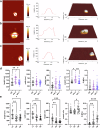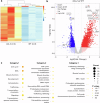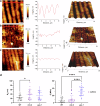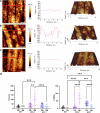Validation of metaxin-2 deficient C. elegans as a model for MandibuloAcral Dysplasia associated to mtx-2 (MADaM) syndrome
- PMID: 39462037
- PMCID: PMC11513083
- DOI: 10.1038/s42003-024-06967-z
Validation of metaxin-2 deficient C. elegans as a model for MandibuloAcral Dysplasia associated to mtx-2 (MADaM) syndrome
Abstract
MandibuloAcral Dysplasia associated to MTX2 gene (MADaM) is a recently described progeroid syndrome (accelerated aging disease) whose clinical manifestations include skin abnormalities, growth retardation, and cardiovascular diseases. We previously proposed that mtx-2-deficient C. elegans could be used as a model for MADaM and to support this, we present here our comprehensive phenotypic characterization of these worms using atomic force microscopy (AFM), transcriptomic, and oxygen consumption rate analyses. AFM analysis showed that young mtx-2-less worms had a significantly rougher, less elastic cuticle which becomes significantly rougher and less elastic as they age, and abnormal mitochondrial morphology. mtx-2 C. elegans displayed slightly delayed development, decreased pharyngeal pumping, significantly reduced mitochondrial respiratory capacities, and transcriptomic analysis identified perturbations in the aging, TOR, and WNT-signaling pathways. The phenotypic characteristics of mtx-2 worms shown here are analogous to many of the human clinical presentations of MADaM and we believe this validates their use as a model which will allow us to uncover the molecular details of the disease and develop new therapeutics and treatments.
© 2024. The Author(s).
Conflict of interest statement
The authors declare no competing interests.
Figures







References
Publication types
MeSH terms
Substances
Grants and funding
LinkOut - more resources
Full Text Sources
Molecular Biology Databases
Miscellaneous

